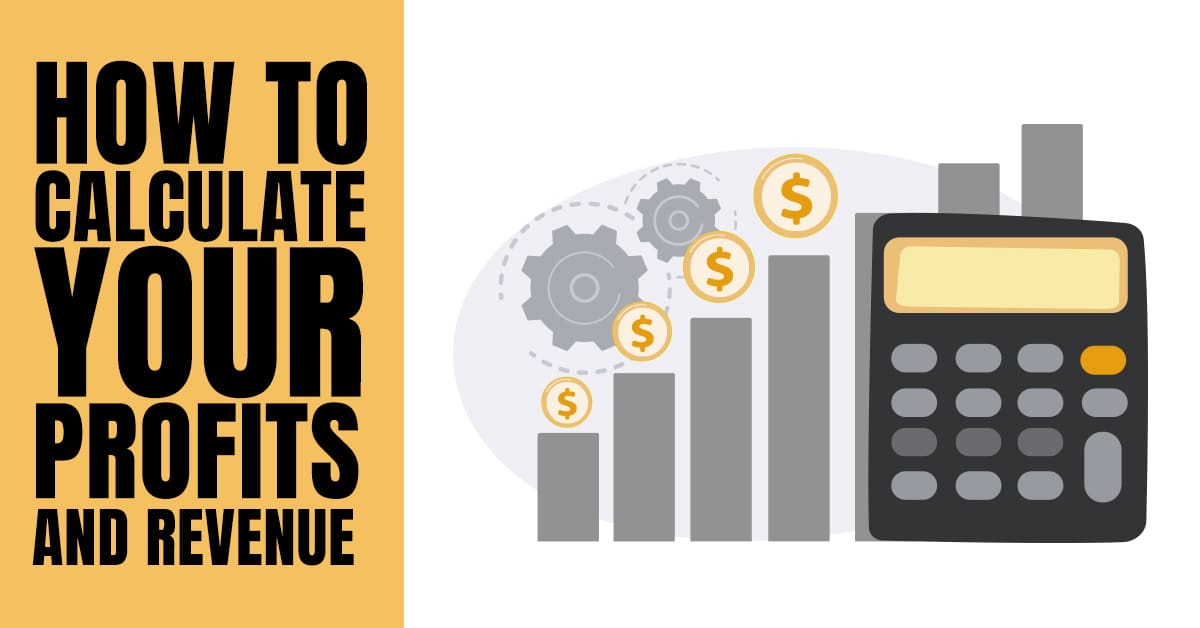
How to Calculate Revenue and Profit Margins

The eCommerce industry provides countless opportunities to grow your online business, expand your reach, and build a powerhouse brand, but you have to monitor several elements to realize this potential. While there are many metrics business owners must track to determine and expand their success, one of the most important is revenue — the fuel of a company. It’s key for evaluating your business’s performance and growth, as well as measuring the efficiency of your marketing and sales strategies, so you need to have precise numbers to make strategic decisions.
In this article, we’ll explore what revenue is, how it’s calculated, and dig into one of its most influential factors, profit margins. We’ll also discuss how to pinpoint your unique profit margins using manual and automated methods.
What is revenue?
Revenue is the income a business generates through the sale of goods or services. It’s a crucial metric for any eCommerce professional, as it’s the lifeblood of any business, be it online or physical. Understanding revenue and how to increase it is important to achieve success.
A few key factors impact revenue:
- Product pricing: Setting the right price for your products is essential to maximize revenue. This entails understanding the cost of goods and the value your products offer to customers. You also need to look at your competition and price your products accordingly (more on that later).
- Product availability: Ensure your products are in stock and readily available to customers. That requires a reliable supply chain and inventory management system.
- Marketing and advertising: Identify and target the right customer segments, develop effective marketing campaigns, and leverage social media and other digital channels to reach potential customers.
- Customer service: Provide excellent customer service, which includes being responsive to customer inquiries and complaints and fostering a sense of loyalty among your consumers.
To calculate revenue, multiply the number of units sold by the price of each unit. For example, if a business sells 100 units of a product at $20 each, its revenue would be $2,000.
An alternative method is to sum up all of the individual sales made within a specific period of time. It’s important to track revenue regularly to monitor your business performance and make informed decisions about pricing, marketing, and other key aspects.
What are profit margins?
Profit margins, on the other hand, refer to the amount of money left over after all expenses have been taken into account. To calculate profit margins, businesses subtract their cost of goods sold (COGS) from their revenue. COGS includes the cost of materials and labor needed to produce the product, as well as any other expenses related to the product, such as shipping and handling.
Many factors can impact profit margins. Take the last couple of years, for example. The Covid-19 pandemic caused labor stoppages and shortages with manufacturing grinding to a halt due to outbreaks. This spurred a shortage of goods and materials, driving up the prices of goods. Merchants saw their profit margins shrinking as a result of higher acquisition costs.
If fixed overhead expenses like the cost of warehousing space, insurance, admin salaries, utilities, and licensing or permits (among other things) change due to inflation, needing a bigger space, or hiring new employees, will also impact your profit margins.
And, of course, there are other factors like taxes and financing or interest costs. With inflation currently on the increase, keeping an eye on your profit margins should be of the highest priority.
Generally, a good target profit margin for eCommerce businesses is around 20%. This means a business should aim to make 20 cents in profit for every dollar of revenue. However, margins can vary widely depending on the industry and the individual business. For example, businesses selling low-cost items may have lower margins, while businesses selling luxury goods might enjoy higher margins.
Note: It’s also important to focus on other metrics alongside profit, including customer lifetime value, customer acquisition cost, and return on investment.
Ensure your pricing is competitive but still profitable
eCommerce professionals face a delicate balance between offering competitive pricing without sacrificing profits. However, with a few key strategies and a bit of negotiation, it’s possible to achieve this harmony and drive more sales for your business.
Negotiate costs with suppliers
One of the most effective ways to keep costs down and maintain competitive prices is to negotiate with suppliers. By building strong relationships with your product sources, you can secure lower prices for bulk orders, early payment discounts, and other incentives. Additionally, you can seek longer payment terms, which improves your cash flow and reduces your overall costs.
Minimize fulfillment costs
Lowering your shipping and fulfillment expenses can keep costs down significantly. Bundling items together, for example, makes shipping more cost-efficient by reducing the number of packages you have to ship. Also, explore alternative shipping options such as using ground shipping instead of air, or partnering with a third-party fulfillment service.
Leverage upselling and cross-selling
By offering complementary products or upgrades, you can increase your customer’s average order value and drive more revenue for your business. Consider discounts and promotions as well to encourage customers to buy more items or make repeat purchases.
Additionally, look into implementing a dynamic pricing strategy that allows you to adjust your prices based on market conditions, supply and demand, and other factors. This will help you to be competitive as well as maximize your profits.
Most importantly, review your costs and pricing regularly to ensure you remain competitive and profitable. By keeping an eye on your expenses and adjusting your prices as necessary, you’ll easily strike that balance between reasonable pricing and a healthy profit margin.
How to calculate your target profit margin
To find your unique profit margin, first, determine your revenue. This is the total amount of money you bring in from sales. Then, sum up your costs, including both fixed and variable expenses. Fixed expenses are those that remain the same regardless of the level of sales, such as rent and salaries. Variable expenses, on the other hand, fluctuate based on sales volumes, such as the cost of goods sold and shipping costs.
Once you know your revenue and costs, you can calculate your profit margin by dividing the net profit (revenue minus costs) by the revenue, then multiplying by 100. For example, if your revenue is $100,000 and your costs are $80,000, your net profit would be $20,000 and your profit margin would be 20% — which, as mentioned above, is a great percentage to aim for.
Translate the numbers
You need a profit margin that’s high enough to cover your expenses and provide a reasonable return on investment. The exact number will depend on the specifics of your business and the level of competition in your market. However, a profit margin of at least 10% is considered to be the minimum for most businesses.
Another impactful factor in your profit margin calculation is the industry you’re in. Some have higher profit margins than others. For example, businesses in the technology and software sector tend to have higher profit margins than those in the retail industry.
Keep in mind, though, that a high-profit margin doesn’t always equate to success; other factors, such as customer satisfaction and market share, also play important roles. Even if a business has high margins, it shouldn’t fall into a false sense of security, as the market and competition can change quickly. Monitor and adjust your business strategy continuously to maintain healthy gains.
Consider tools to handle the math
The traditional method of calculating revenue and profit margins usually involves spreadsheets, calculators, and good old-fashioned mathematics. This is a viable solution for smaller companies with straightforward calculations. However, manually crunching numbers can be time-consuming and cumbersome, if your business needs require you to look at various potential outcomes based on pricing changes or sales boom or bust cycles.
When it’s no longer feasible to calculate your revenue manually, look to tools for support. Many options are available, and businesses frequently take advantage of them because they’re:
- Fast and easily accessible: Tools take care of the heavy lifting of mathematics for you with just a few clicks. Solutions like revenue or profit margin calculators easily enable you to better manage your business goals and planning to push you toward success and sales growth.
- More cost-effective than outsourcing: You could hire an accountant or business analyst to look at your books and create projections. However, hourly rates add up and will, unfortunately, cut into those profit margins you’re trying to grow. In addition, outsourcing these activities impacts your ability to make fast decisions, as it can take time for a professional to run the numbers.
- Able to show possible outcomes: By comparing your revenue against your profit margins, you can optimize your business activities. This can mean cutting business costs, raising prices, changing suppliers, and more.
Tools let you plug in numbers quickly and easily, then the algorithm does the work so you can determine the best way forward for your unique eCommerce needs. Most accounting software will include profit margin calculations that you can use to understand your unique business’ margins and the factors that impact them. You can also select one of the many bespoke options, ranging from high-cost to no-cost online.
Omni Margin Calculator
The Omni Margin Calculator will generate your gross margins based on the numbers you input. This free tool is available online and takes only a few moments to plug in your data. Better still, it has additional features/calculators that can break down GST, VAT, Sales tax, and more.
Oberlo Profit Margin Calculator
Similar to the Omni mentioned above, Oberlo offers an always-free calculator for profit margin calculations. Simply input the data to calculate your margins and use the information to set prices.
MyFBAPrep Profit Margin Calculator
A quick Google Search for “profit margin tools” uncovers more than one hundred thousand results! It can feel overwhelming with so many tooling options available. Make it easy on yourself and look into the MyFBAPrep Profit Margin Calculator. This free tool quickly calculates your profit margins so you understand how to grow your business. It reduces the risk of human error by automating processes and even provides a ready-made, fool-proof template for calculations.
The template allows you to work faster and reuse formulas for quick calculations with little additional effort. It also maintains consistency between calculations for different possibilities, such as higher or lower price points, fluctuating business costs, or a combination of minor tweaks. Simply fill out the tool and let the Profit Margin Calculator do all the work. Unlike the tools above, you can keep your calculations to reflect back on if things change for easy comparisons.
Wrapping Up
Revenue and profit margins are important metrics (among others) for measuring the performance and growth of an eCommerce business. While 20% is a good base target for eCommerce businesses, ultimately, your industry and specific business makeup will determine the margin you should aim for.
Both front- and back-end factors affect these metrics, from your marketing and advertising to your supplier relationships. Gather relevant data and run the numbers, using either manual methods or a tool like MyFBAPrep’s Profit Margin Calculator, to see where your business performs well and where it has room to improve. By relying on accurate calculations, you’ll steer your company on course toward growth and greater profitability.



